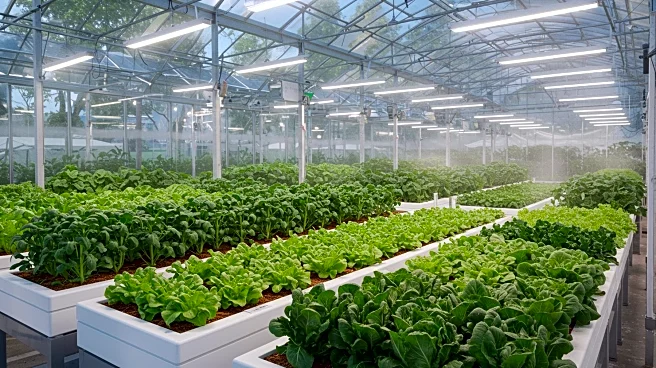What's Happening?
Yuma, Arizona, a key agricultural hub in the United States, is leveraging advanced technologies and sustainable practices to maintain its status as a major supplier of winter vegetables. Known as the 'Winter Lettuce Capital of the World,' Yuma produces over 90% of the nation's leafy greens during the winter months. The region's success is attributed to its unique desert climate, fertile soil, and access to the Colorado River. In 2025, Yuma's agriculture is characterized by the adoption of precision farming technologies, such as GPS-guided equipment, soil moisture sensors, and drones for crop surveillance. These innovations enable farmers to optimize resource use, improve crop yields, and ensure environmental sustainability. Additionally, blockchain traceability is being used to enhance food safety and consumer trust by providing transparent records of produce from seed to shelf.
Why It's Important?
The advancements in Yuma's agricultural practices are crucial for sustaining the U.S. food supply, particularly during the winter months when other regions cannot produce leafy greens. By adopting precision agriculture and sustainable practices, Yuma not only ensures a steady supply of fresh produce but also addresses challenges such as water scarcity and labor shortages. The use of technology in farming enhances efficiency, reduces waste, and supports environmental stewardship, which is increasingly important in the face of climate change. Moreover, the integration of blockchain technology in the supply chain builds consumer confidence and opens up opportunities for premium pricing. These developments position Yuma as a model for resilient and innovative agriculture, which is vital for the economic stability of the region and the broader U.S. food system.
What's Next?
Yuma's agricultural sector is expected to continue evolving with further integration of digital innovations and sustainable practices. The focus will likely remain on enhancing water efficiency and crop resilience to adapt to ongoing climate challenges. As technology becomes more embedded in farming operations, Yuma's farmers may increasingly rely on AI-based decision systems and satellite monitoring to make informed, real-time decisions. The role of local farmers markets will also grow, providing direct-to-consumer connections and supporting regional food security. Policymakers and local institutions are likely to invest in research and technology transfer to ensure Yuma's continued leadership in sustainable agriculture.
Beyond the Headlines
The shift towards precision agriculture in Yuma highlights broader ethical and cultural dimensions, such as the importance of food security and the need for sustainable resource management. As the region adapts to climate pressures, it sets a precedent for other agricultural areas facing similar challenges. The emphasis on blockchain traceability also reflects a growing consumer demand for transparency and authenticity in food sourcing. These trends may lead to long-term shifts in how agricultural products are valued and marketed, potentially influencing national policies on food safety and environmental sustainability.











